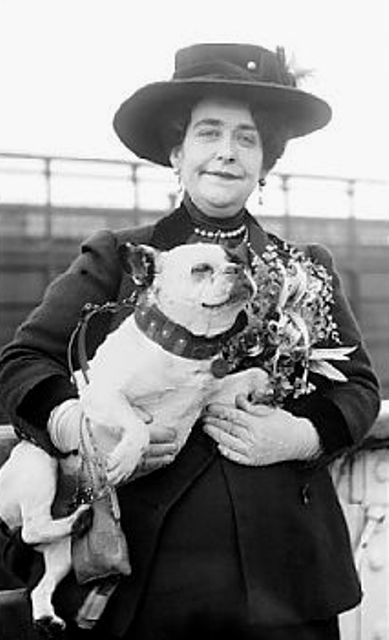
Aimée Isabella Crocker Ashe Gillig Gouraud Miskinoff Galitzine with one of her many pampered bulldogs.
This story is about three French bulldogs, the first cricket club in New York City, an old farm, and a grand hotel called Gilsey House. It stars a pseudo-princess named Aimée Isabella Crocker Ashe Gillig Gouraud Miskinoff Galitzine.
If I had the ability, I’d turn this Old New York tale into a movie.
Part I: Aimée Isabella Crocker and Peter Gilsey
The princess was born Amy Isabella Crocker on December 5, 1864, in Sacramento, California. Her father, Judge Edwin Bryant Crocker, was the chief legal counsel for the Central Pacific Railroad. He was also one of the principal investors for the world’s First Transcontinental Railroad.
When E.B. Crocker died in 1875, Aimée was left with a fortune of $10 million.
Much has been written Ms. Crocker, and I’d rather focus on the history of the Gilsey House. However, a quick summary of her eccentricities is warranted for one to fully appreciate this two-part story.
In a nutshell, Aimée Crocker was a wealthy heiress who embraced Buddhism and once joined an Asian harem just for kicks. She had a giant tattoo of a blue python on her left arm and loved doing snake dances for her Bohemian friends. (As they say, her father was probably rolling over in his grave.)
She also enjoyed collecting things, including bulldogs (at least 25) and husbands (5).
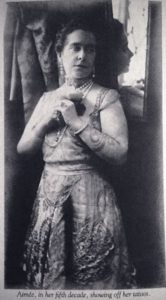
In 1924, after spending an extended time in the Far East, Aimee Crocker returned to New York City sporting a python tattoo.
Aimee’s first husband, Porter Ashe, “won” Miss Crocker in a poker match in 1883, when Aimee was just 19.
Reportedly, Ashe drew four aces during a match with another suitor, Henry Mansfield Gillig, which earned him the right to claim his young bride. (Aimee also got quite the prize: Porter’s forefathers gave their name to Asheville, North Carolina; his uncle was the great Civil War Admiral David Farragut.)
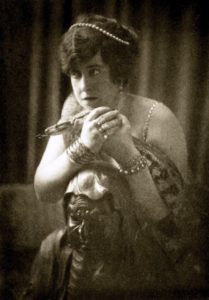
Aimee Crocker reportedly acquired her pet python in India (the fangs had been removed). She was often seen riding down Fifth Avenue with the snake wrapped around her shoulders.
Aimée’s first marriage did not last long (none of her marriages had staying power). This story takes place in 1889, the year Aimée married her second husband. Surprise, surprise, this was Mr. Henry Gillig, the wealthy San Francisco banker who lost her in the poker match six years earlier.
Aimee and Henry made their New York City winter home at the Gilsey House, a luxury hotel at 1200 Broadway. It was here that their three bulldogs — Dicbutau, Shugi, and Boola Boy — lived in fairy-tale luxury.
Not only did they have their own room, but these pooches had a personal footman (paid $30 a month) and maid ($25 a month) who catered to their every canine need.
Peter Gilsey and the Gilsey House
The Gilsey House was designed by Stephen Decatur Hatch for Peter Gilsey and constructed from 1869 to 1871 at the cost of $350,000. The seven-story, 300-room hotel featured rosewood and walnut finishing, marble fireplace mantles, bronze chandeliers, and tapestries. The hotel also had “speaking tubes” in each room that provided a direct form of communications with the main desk.

The Gilsey House at 1200 Broadway (extant), on the northeast corner of East 29th Street, celebrated its grand opening on April 15, 1871. The Marble Collegiate Church, built in 1854 and also still standing, is in the background. NYPL Digital Collections
Peter Gilsey, a wealthy New York City merchant and city alderman, is the epitome of the American dream. Born in 1811 in the Province of Jutland, Denmark, he started out making moderate wages in a New York City piano factory after emigrating to America 1827. Within a few years, he had saved enough money to start his own business as a retail tobacconist in the Bowery near Prince Street.
Peter was quite successful in his new trade, and he was soon able to move to a larger location on Broadway and Cortlandt Street. It was here, in 1854, that he built the Gilsey Building. Located on the site of a former wood frame building owned by Bogart the baker, the Gilsey Building was one of the first large iron structures erected in New York City.
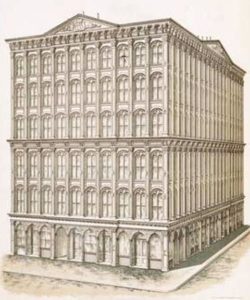
The Gilsey Building at 171 Broadway was constructed in 1854 on the site of Peter Gilsey’s tobacco store and a bakery. Museum of the City of New York Collections
Peter Gilsey went on to become a New York City real estate tycoon, erecting numerous buildings in the new theater district along Broadway. His properties included the Coleman House hotel on the northwest corner of Broadway and West 27th Street (1867), and Apollo Hall at 31 West 28th Street (1868).
Gilsey Leases the Casper Samler Farm
In 1869, Gilsey leased a large plot of land on Broadway between West 29th and West 30th Street for $10,000 a year from the estate of Casper Samler. The plot, designated Lot 2 of the old Samler Farm, included the former homestead of Casper Samler.
It was on the site of this old homestead where Peter Gilsey constructed the Gilsey House. And it was here where three very spoiled bulldogs lived in luxury for two years until their mistress married again…
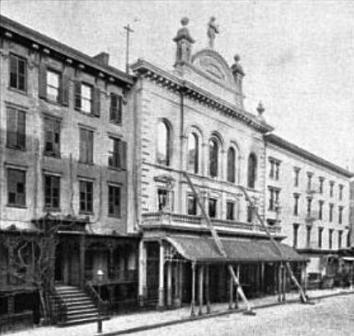
Peter Gilsey lived at #33 West 28th Street (left) until his death there in 1873. To the right is the old Fifth Avenue Hotel, formerly Apollo Hall. Gilsey’s wife, Mary, continued to live in the home until January 1891. She died there on September 13, 1891. Today a parking garage occupies this site.
In Part II of this Old New York dog story, I’ll tell you more about the Casper Samler farm (which has a connection to New York City’s first cricket club). I’ll also report on the wonderful life of Amy Crocker Gillig’s three bulldogs at the Gilsey House.


